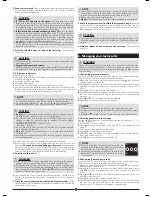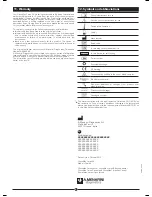
2
TIME:
shows time (HH:MM, 12H AM/PM or 24H
format).
AVERAGE:
shows the period related to the displayed
average (1, 7, 14, 30, 60 or 90 days – §6.2).
DATE:
shows the date (DD-MM format).
MARKERS ICONS:
displayed while marking a test result (§4.4)
or reviewing a marked result.
Before meal marker.
After meal marker.
Exercise marker.
Check marker.
GLUCOSE ICON:
appears when the value shown in the Main
Display Area refers to glucose test results.
KETONE ICON:
appears when the value shown in the
Main Display Area refers to β-ketone test
results, while setting the β-ketone test alert
threshold or, if blinking and displayed after
a glucose test, to indicate that a β-ketone
measurement is suggested (§4.2).
WRONG TEMPERATURE
ICON:
appears while testing and temperature is
outside the allowed temperature range.
LOW BATTERY ICON:
appears when the battery needs to be
replaced (§8.3).
NFC ICON:
displayed while setting the NFC (Near
Field Communication) function (§7.6) and
when this function is enabled; blinks while
data are transmitted via NFC (§6.3.1).
CTL ICON:
indicates a control solution test (§4.3).
2.2 TEST STRIP
The following picture describes the structure of both GlucoMen® areo
Sensor and GlucoMen® areo β-Ketone Sensor.
GlucoMen® areo Sensor is white, GlucoMen® areo β-Ketone Sensor is in
light purple colour.
APPLY BLOOD/CTRL
SOLUTION DROP HERE
CHECK WINDOW
INSERT THIS END INTO
THE METER
3. Before testing
3.1 Caution when using the meter
Time and date are pre-set in the meter. Please make sure that time and
date settings are correct before first use, and adjust them if needed.
Always check the settings after changing the battery (§8.3).
CAUTION
●
For accurate test results, allow the meter, test strips and control
solution to adjust to the surroundings for 30 minutes before testing
your blood glucose or β-ketone levels:
Glucose test
- temperature: 5 to 45 °C (41 to 113 °F);
- humidity: 20 to 90% RH (Relative Humidity).
β-Ketone test
- temperature: 10 to 40 °C (50 to 104 °F);
- humidity: < 85% RH.
●
Do not store or use the meter where:
- there are sharp temperature fluctuations;
- humidity is high and causes condensation (bathrooms, drying rooms,
kitchen, etc.);
- there is a strong electromagnetic field (close to a microwave oven,
cell phone, etc.).
●
Do not use the meter if it has been dropped in a liquid or liquids have
entered inside, even if dried afterwards.
●
Avoid hand contact with test strip port on the meter. A thermo sensor
is housed inside the meter to minimize any errors.
●
Do not connect the data cable to the data transfer port during testing.
The meter may be damaged, leading to inaccurate test results.
●
Do not apply blood directly to the test strip port on the meter.
●
Do not share your meter with anyone else to avoid the risk of infection.
●
The meter complies with applicable electromagnetic emission
requirements (EMC). However, do not perform measurements with this
meter near mobile devices or electrical or electronical equipment that
are sources of electromagnetic radiation, as these may interfere with the
proper operation of the meter.
3.2 Caution when using the test strips
CAUTION
●
For testing with GlucoMen® areo 2K meter use GlucoMen® areo
Sensor or GlucoMen® areo β-Ketone Sensor only. Do not use other
test strips, it causes inaccurate test results.
●
Do not use test strips after their expiry date. The expiry date is either
written on the test strip vial next to the symbol (glucose sensor) or
on the foil pouch (β-ketone sensor).
For accurate test results, allow the meter and test strips to adjust to
the surroundings for at least 30 minutes before testing your blood
glucose or β-ketone levels:
Glucose test
- temperature: 5 to 45 °C (41 to 113 °F);
- humidity: 20 to 90% RH.
β-Ketone test
- temperature: 10 to 40 °C (50 to 104 °F);
- humidity: < 85% RH.
●
Do not use the GlucoMen® areo Sensor test strips if 9 months or more
have passed since first opening the vial.
●
The test strips are for single-use only. Do not use test strips that have
already absorbed blood or control solution.
●
Keep all unused test strips in the original vial and after having removed
one, immediately close the cap tightly to preserve their quality. Do not
transfer them into any other container.
4. Measuring your blood glucose levels
4.1 Blood sampling
For information on how to use the lancing device, read the relevant
instructions for use.
CAUTION
●
Wash the puncture site with soap and water and dry the site thoroughly
before sampling blood.
●
Do not share the same lancet or lancing device with anyone else to
avoid the risk of infection.
●
Always use a new lancet. Lancets are for single-use only. Do not reuse
a lancet that has already been used.
4.1.1 Alternative site testing (AST)
This meter can test the glucose levels of blood
from your fingertip, palm and forearm. However,
test results from sites other than the fingertip
may differ from fingertip measurements.
Consult your doctor or healthcare professional
before testing blood from the palm or forearm.
Use blood from:
If you are going to test:
Fingertip, palm,
forearm
• Before meals.
• Two hours or more after meals.
• Two hours or more after exercise.
Fingertip
• When there is the possibility of your blood glu-
cose levels changing rapidly (e.g. after meals or
exercise).
• When experiencing symptoms of hypoglycae-
mia such as perspiration, cold sweats, a floating
sensation or trembling.
• When immediate testing is needed for suspect-
ed hypoglycaemia.
• When in poor physical condition, such as with a
head cold, etc.
4.2 Testing your blood glucose
1. Insert a new GlucoMen® areo Sensor test strip (white colour) into the
test strip port. The drop icon starts blinking on the screen and the
glucose icon “GLU” will be shown at the bottom left hand corner of the
display. If nothing appears on the screen, remove the test strip, insert it
into the test strip port again and wait for the drop icon to start blinking.
2. Apply the drop of blood to the tip of the test strip until the check
window is full. A beeper sounds (if enabled) and a countdown timer
starts on the screen.
NOTE
●
For accurate test results, apply the drop of blood to the tip of the test
strip within 20 seconds after puncturing.
●
Do not test blood that runs or spreads out from the puncture site.
●
Do not smear blood onto the test strip.
●
Do not forcefully press the test strip into your puncture site.
●
Do not touch the test strip once the meter has started the countdown.
3. Read your test result. You will hear a beep when the test result appears
on the screen together with the glucose icon “GLU”.



















